
To prevent rapid bacterial growth on salmon, it must be kept out of the "danger zone" for prolonged periods. Between thawing and cooking times, salmon shouldn't be between 40 and 90 degrees Fahrenheit for longer than two hours or between 90 and 140 F for longer than one hour. Baking and grilling are suitable ways to cook frozen salmon; both methods heat it from the frozen state, or about 0 F, to a completely cooked temperature of 145 F, which is efficient enough to stave off dangerous bacterial growth.
Quality Considerations
frozen salmon may not cook evenly, as its outer flesh thaws sooner than the center. This can yield overcooked exteriors and may be a problematic if a filet has a thin and a thick side; normally, the solution is to fold the thin side underneath to make a piece of uniform thickness, but of course you can't do that to a frozen cut. Also, you can't effectively season frozen salmon. Salt, pepper and other aromatics, spices and herbs won't stick to it, and a marinade can't penetrate frozen flesh. You'll have to wait to add flavoring agents until your salmon is partially or fully cooked.
Safe Ways to Thaw
Plan ahead and thaw salmon by moving it into the refrigerator a day or two ahead of time. For faster defrosting, soak it in a cold-water bath for one to two hours. Seal the salmon in a leak-proof bag if it isn't already in airtight packaging and replace the water every half hour to keep it cold. Your microwave's defrost function is a third option that takes only a few minutes. However, the microwave begins cooking the outer meat, so it may turn out overcooked in the end.
Baking Frozen Salmon
Preheat the oven to 325 F. It's standard to cook salmon at a higher temperature, but heating it more gently minimizes or prevents the outer flesh from overcooking. Place a greased sheet of foil or parchment paper on a baking tray and put the salmon steak or filet on top. Because it's frozen, the estimated cooking time is extended by around 50 percent. So bake the fish for approximately 22 to 32 minutes, depending on its thickness. It's finished when the flesh is flaky and opaque all the way through.
Grilling Frozen Salmon
Preheat the grill to medium heat, rather than the more typical moderately high temperature, to gently cook it. Scrape the grill clean and grease it thoroughly. Place the salmon presentation-side down first, so it can develop attractive grill markings. Because cooking time is about 50 percent longer than the time it takes for defrosted salmon, cook the frozen filet or steak for about 5 to 7 minutes per side, just until the inside is entirely opaque and flaky.
Related Articles
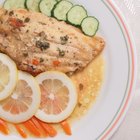
Grilling a Frozen Tilapia in Foil

Baking Partially Frozen Salmon

Can You Cook Frozen Salmon Whole?
How to Bake Salmon So It's Tender

Cooking Frozen Swai Fillets

How to Cook Frozen Salmon Fillets ...
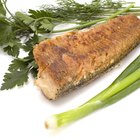
How to Freeze Cod Fish

How Long Do You Bake Salmon in Foil ...
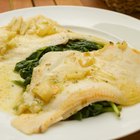
How to Cook a Flounder Filet

How to Cook Frozen, Boneless & Skinless ...

How Long Does It Take for Salmon to ...

How to Cook a Whole Rainbow Trout
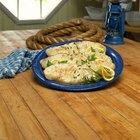
How to Prepare Fabulous Baked Halibut

Can You Cook Fish Frozen?

How to Bake Lingcod

How to Cook Salmon Fillets on the Stove ...
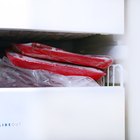
How Long Do You Keep Meat in Freezer?

How to Cook Ono Fish
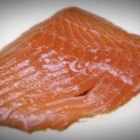
How to Make Homemade Smoked Salmon
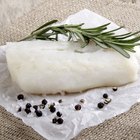
How to Defrost Cod
References
- U.S. Food and Drug Administration: Fresh and Frozen Seafood -- Selecting and Serving it Safely
- U.S. Department of Agriculture: The Big Thaw -- Safe Defrosting Methods for Consumers
- U.S. Department of Agriculture: Danger Zone
- McCormick: Herb Baked Salmon Recipe
- My Recipes: Cooking Light's Sesame Salmon with Green Onions and Lemon
- Food and Wine: Honey-Mustard-Glazed Salmon Steaks
- My Recipes: Cooking Light's Grilled Salmon and Brown Butter Couscous
Writer Bio
Eric Mohrman is a food and drink, travel, and lifestyle writer living in Orlando, Florida. He has professional experience to complement his love of cooking and eating, having worked for 10 years both front- and back-of-house in casual and fine dining restaurants. He has written print and web pieces on food and drink topics for Visit Florida, Orlando Style Magazine, CrushBrew Magazine, Agent Magazine, Dollar Stretcher Magazine, The 863 Magazine and other publications.
Photo Credits
Jupiterimages/Photos.com/Getty Images